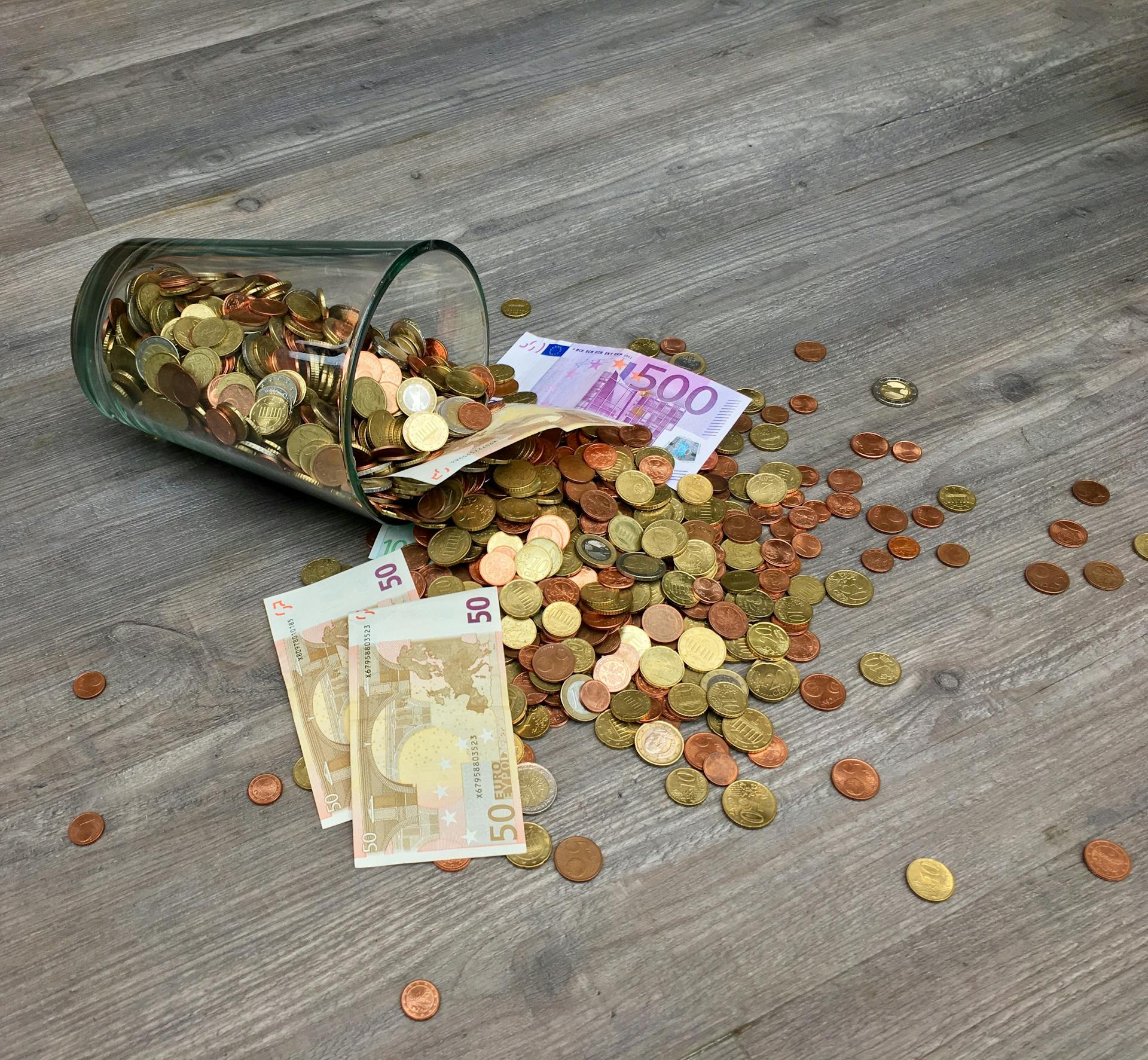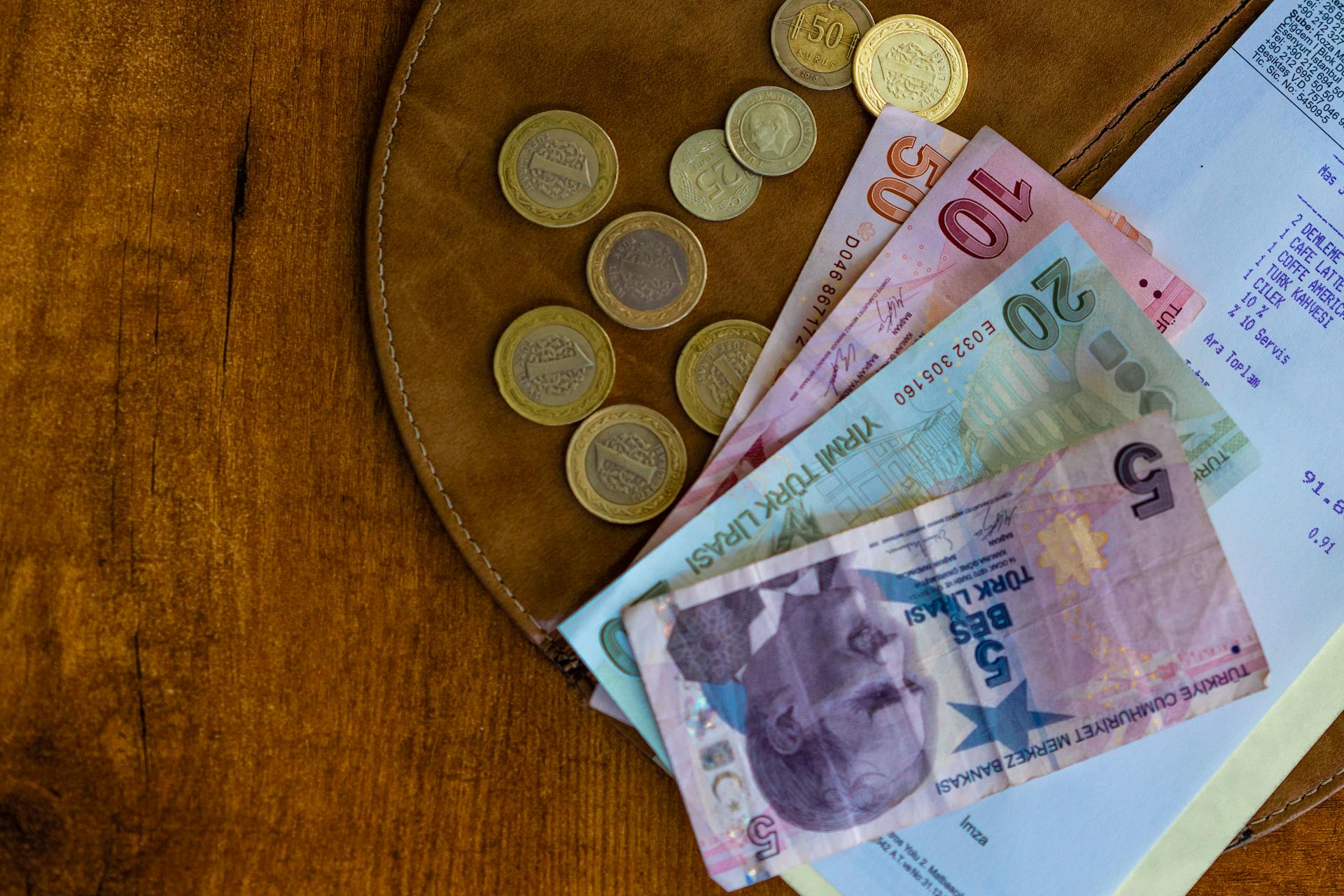
The Italian Lira was the official currency of Italy from 1861 to 2002. It was subdivided into 100 centesimi.
The Lira was first introduced in 1861, replacing the Sardinian Lira. This marked the beginning of a unified Italian currency.
The Lira was widely used in Italy and was also accepted in San Marino and the Vatican City.
History of Italian Lira
The Italian lira has a rich and fascinating history that spans over a century. In 1861, coins were minted in Florence, Milan, Naples, and Turin in various denominations, including copper, silver, and gold.
The first coins minted in Florence, Milan, Naples, and Turin in 1861 were made of copper, silver, and gold, with the lowest four denominations in copper, the highest two in gold, and the remainder in silver. This marked the beginning of the Italian lira's journey.
In 1863, silver coins below 5 lire were debased from 90% to 83.5%, and silver 20-centesimo coins were introduced. This change had a significant impact on the coinage system.
The coinage system remained relatively unchanged until the First World War, with the introduction of cupro-nickel (later nickel) 20-centesimo coins and nickel 25-centesimo pieces in 1894 and 1902, respectively.
Here's a brief overview of the major changes to the Italian lira:
The Italian lira continued to evolve until its eventual replacement by the Euro in 2002.
20th Century
The 20th century was a tumultuous time for the Italian lira. World War I broke the Latin Monetary Union, causing prices to rise several fold in Italy.
Inflation was a major issue, but Mussolini's government implemented a new exchange rate between the lira and sterling in 1926, pegging the lira to the pound at a rate of £1 = Lit92.46. This was a significant change from the free exchange rate, which had been closer to Lit140-150 to the pound.
The lira continued to fluctuate in value, with a separate "tourist" rate of $1 = Lit24.89 being established in 1936. By 1939, the official rate had changed to Lit19.80.
In 1943, the exchange rate was set at $1 = Lit120 (£1 = Lit480) after the Allied invasion of Italy. However, in German-occupied areas, the exchange rate was set at 1ℛ︁ℳ︁ = Lit10.
After the war, the value of the lira continued to fluctuate, with a peg of $1 = Lit575 being set within the Bretton Woods System in November 1947. This rate was later devalued to $1 = Lit625 in 1949.
Here's a brief summary of the exchange rates during this period:
The lira continued to face challenges, including high inflation, until the introduction of the euro.
Between 1814-1861
The lira remained present in Italy only in the Duchy of Parma and the Kingdom of Piedmont-Sardinia after the end of the Napoleonic Kingdom of Italy in 1814.
Duchess Marie Louise, Duchess of Parma, introduced the lira of Parma with coin denominations of 1, 3, 5, 25, 50 cents and 1, 2, 5, 20 and 40 lire.
Gold coins of 10, 50, 80 and 100 lire were minted from the Piedmont-Sardinia lira introduced by Victor Emmanuel I of Savoy.
The lira of Parma and the Piedmont-Sardinia lira coexisted until the AM-lira was issued in 1943.
The AM-lira was in circulation in Italy after the landing in Sicily on the night of 9 July 1943.
The AM-lira ceased to be the currency of employment after 1946 and was used along with normal notes, until 3 June 1950.
Currencies Formerly Related
The Italian Lira has a fascinating history, and its connections to other currencies are an interesting part of that story.
The Lira was pegged to the French Franc from 1865 to 1927, which had a significant impact on the Italian economy.
The French Franc was a major currency in Europe at the time, and pegging the Lira to it helped stabilize the Italian economy.
The Lira was also pegged to the Pound Sterling from 1927 to 1934, a move that aimed to strengthen the Italian currency.
The Italian Lira was part of the European Monetary Unit (EMU) from 1990 to 1999, a precursor to the Euro.
The Lira's time in the EMU was marked by a significant increase in trade and economic cooperation between Italy and other European countries.
Etymology and Notation
The Italian lira has a rich history, and its etymology is rooted in the Carolingian monetary system, which divided the libra into 20 solidi or 240 denarii. This system translates to lira, soldo, and denaro in Italian.
The name "lira" was also adopted in France to refer to a coin worth one livre tournois, and it was used in various Gallo-Italic languages in northwestern Italy to refer to the Italian lira.
The Carolingian monetary system's influence can be seen in the English language as well, where the pound, shilling, and penny are equivalent to the lira, soldo, and denaro.
Etymology
The Carolingian monetary system was a complex system that divided the libra into 20 solidi or 240 denarii.
These units were the foundation of various European currencies, including the Italian lira, French livre, and English pound. The solidus, denarius, and denier were all part of this system.
In France, the "franc" referred to a coin worth one livre tournois.
The term "franc" was also adopted in various Gallo-Italic languages in north-western Italy to refer to the Italian lira.
The Italian lira, French livre, English pound, and their respective subdivisions like the soldo, sou, shilling, and penny all originated from the Carolingian monetary system.
Notation and Symbols
The Italian lira didn't have a standard sign or abbreviation, but several representations were accepted, including Lit., L., ₤, and £.
Banks and financial institutions, like the Bank of Italy, often used Lit. as their abbreviation for the Italian lira.
Handwritten documents and market stalls might use £ or ₤, while coins typically used L.
Italian postage stamps usually wrote out the word "lire" in full, but some series, like the 1975 monuments series, used "L."
You might see the name of the currency written in full as a prefix or suffix, like Lire 100,000 or 100,000 lire.
The ISO 4217 currency code for the lira was ITL.
The Unicode CJK Compatibility block includes square versions of currency names in Japanese katakana, like U+3352 ㍒ SQUARE RIRA, which stands for リラrira.
Introduction and Replacement
The Italian lira was introduced in 1807 by the Napoleonic Kingdom of Italy, at par with the French franc. It was worth 4.5 grams of fine silver or 0.29032 gram of fine gold.
The lira eventually replaced the currencies of the different Italian states until their unification in 1861. This included the Piedmontese scudo, Sardinian scudo, and Genoese lira, among others.
Here's a list of some of the currencies that were replaced by the lira:
- The Piedmontese scudo, Sardinian scudo, and Genoese lira after 1800;
- The Milanese lira, Venetian lira, Lombardo-Venetian lira, and Parman lira after 1814;
- The Tuscan fiorino and Tuscan lira in 1859;
- The piastra of Naples and Sicily in 1861;
- The scudo of Rome and the Papal States in 1866.
In 1865, Italy joined the Latin Monetary Union, where the lira was set equal to the French, Belgian, and Swiss francs.
Republic, 1946-2002
In 1946, coin production was resumed, but it wasn't until 1948 that numbers minted exceeded 1 million, with the purchasing power of the lira reduced to 2% of that of 1939.
Four aluminium coin denominations were initially issued: 1, 2, 5, and 10 lire, which circulated alongside the AM-lire and some devalued coins from the Italian Kingdom.
The government decided to replace all circulating coins and bills with new aluminium coins in 1951, introducing smaller-sized 1, 2, 5, and 10 lire coins, although the 2-lira coin was not minted in 1951 or 1952.

Acmonital (stainless-steel) 50- and 100-lira coins were introduced in 1954-1955, followed by aluminium-bronze 20-lira coins in 1957 and silver 500-lira coins in 1958.
The 500-lira coins were produced in small numbers for collectors after 1967 due to the increase in silver bullion price.
Here is a list of coins still being minted for circulation at the time of the changeover to the euro in 2000 and 2001:
- 1 lira (0.05 cents, only for collectors)
- 2 lire (0.10 cents, only for collectors)
- 5 lire (0.26 cents, only for collectors)
- 10 lire (0.52 cents, only for collectors)
- 20 lire (1.03 cents, only for collectors)
- 50 lire (2.58 cents)
- 100 lire (5.16 cents)
- 200 lire (10.33 cents)
- 500 lire (25.82 cents)
- 1,000 lire (51.65 cents)
The 1,000-lira bimetallic coin was introduced in 1997 and stopped in 1998 with the introduction of the euro.
Miniassegni
Miniassegni were a type of notgeld that circulated in Italy in the late 1970s in place of change.
They were issued by many banks and had nominal values of 50, 100, 150, 200, 250, 300, and 350 lire.
The first miniassegni appeared in December 1975, and they were a response to the scarcity of small-denomination coins at that time.
In Italy, small-denomination coins were often substituted with items like candy, stamps, telephone tokens, or even public transport tickets.
The Lega Nord launched a campaign to reintroduce the lira as a parallel currency in 2005, and Beppe Grillo, leader of the Five Star Movement, raised the same point in 2014.
Vatican City

The Vatican City switched to the euro along with Italy and San Marino. This change was a result of the country's concordat with Italy, which established the Vatican lira as an official unit of currency at par with the Italian lira.
Italian lira notes and coins were legal tender in the Vatican City, and vice versa. Specific Vatican coins were minted in Rome and were also legal tender in Italy and San Marino.
The Vatican City has its own set of euro coins, similar to the old Vatican lira coins. This is a unique aspect of the country's currency system.
Introduction
The Italian lira has a rich history that spans over a century. Introduced in 1807 by the Napoleonic Kingdom of Italy, it was initially worth 4.5 grams of fine silver or 0.29032 gram of fine gold.
The lira eventually replaced the currencies of the different Italian states until their unification in 1861. This included the Piedmontese scudo, Sardinian scudo, and Genoese lira, which were replaced by the Italian lira after 1800.
In 1865, Italy formed part of the Latin Monetary Union, where the lira was set as equal to the French, Belgian, and Swiss francs. The U.S. dollar was worth approximately 5.18 Italian lire until 1914.
The lira was the official unit of currency in Italy until 1 January 1999, when it was replaced by the euro. Old lira denominated currency ceased to be legal tender on 28 February 2002.
The conversion rate from lira to euro was 1,936.27 Italian lire to the euro.
Legal and Financial
The Italian lira's legal status was a bit of a rollercoaster. Banknotes and coins in lire ceased to be legal tender on February 28, 2002.
The deadline for converting non-lapsed lira banknotes was initially set for February 28, 2012. However, this deadline was brought forward to December 6, 2011.
This change was later deemed unlawful by the Constitutional Court in 2015. The court's decision led to a new set of rules for exchanging lira currency.
Banknotes
The Italian lira had a complex history of banknotes, with various denominations and designs introduced over the years. The government began issuing low-denomination paper money in 1882, with 5 lire and 10 lire notes.
These early notes were called "Biglietti di Stato" and were occasionally supplemented with 25 lire notes from 1895. The government also issued "Buono di Cassa" notes in denominations of 1 lira and 2 lire between 1893 and 1922.
In 1896, the Bank of Italy started producing paper money, with initial denominations of 50, 100, 500, and 1,000 lire. By 1918-1919, 25 lire notes were also introduced, but no other denominations were added until after World War II.
Here's a list of the denominations of banknotes introduced by the Bank of Italy:
- 50 lire
- 100 lire
- 500 lire
- 1,000 lire
- 25 lire (1918-1919)
The Bank of Italy continued to issue new denominations, including 5,000 and 10,000 lire notes in 1947 and 1948, respectively. The government also reintroduced 1,000 lire notes in 1943, which were followed by a series of "Biglietti di Stato" for 1 lira, 2, 5, and 10 lire in 1944.
The Bank of Italy issued 50,000 and 100,000 lire notes in 1967 and 1975, respectively, and 500,000 lire notes in 1997.
Legal Framework
The legal framework surrounding the Italian lira's transition to the euro was a bit of a rollercoaster ride.
On 28 February 2002, banknotes and coins in lire ceased to be legal tender, marking the beginning of the end for the lira.
The deadline for converting non-lapsed lira banknotes was initially set for 28 February 2012, giving people plenty of time to exchange their currency.
However, in a surprise move, the legislature brought forward the deadline to 6 December 2011, with immediate effect, as stated in Decree Law 201/2011, Article 26.
This decision was later deemed unlawful by the Constitutional Court, which declared it null and void on 7 October 2015.
The Ministry of Economy and Finance was forced to re-evaluate the exchange process, requiring applicants to provide proof of their application to exchange lira currency between 6 December 2011 and 28 February 2012.
In the end, some 268 exchanges were made between 22 January 2016 and 28 February 2016, totaling €2.709.517,96.
Frequently Asked Questions
Can you still use Italian lira?
No, Italian lira is no longer a valid form of payment. Banknotes and coins in lire stopped being accepted as legal tender on February 28, 2002.
Featured Images: pexels.com


